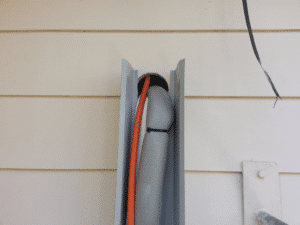Introduction
Proper sealing of wall penetrations is a critical yet often overlooked aspect of air conditioning installation. This guide explains why both indoor and outdoor penetrations must be properly sealed and the problems that can arise from inadequate sealing practices.
Why is Proper Sealing Essential?
Sealing indoor and outdoor penetrations ensures optimal air conditioning system performance and protects the customer’s property. Some installers may believe that sealing only one side is sufficient – this is incorrect and can lead to significant issues.

Common Problems from Improper Sealing
Temperature Control Issues
- When only the outdoor penetration is sealed:
- Drafts can travel through the wall cavity and blow on the indoor unit’s temperature sensor
- This results in false temperature readings
- The system may “overshoot” its target temperature, leading to inefficient operation and customer discomfort
- When neither penetration is sealed:
- Outside temperature can directly influence the indoor sensor
- Draft movement through the wall cavity creates unreliable temperature readings
- System performance becomes erratic and inefficient
Vermin-Related Problems
Unsealed penetrations create multiple risks:
- Access points for vermin to enter the indoor unit, potentially causing:
- Damage to internal components
- Electrical faults
- System failures
- Costly repairs
- Entry points to the building’s ceiling space, which can lead to:
- Property damage
- Health and safety concerns
- Additional pest control expenses
Bushfire Protection
In bushfire-prone areas or properties rated BAL-FZ (Bushfire Attack Level – Flame Zone), proper sealing of wall penetrations becomes even more critical:
- Wall cavities are particularly vulnerable to bushfire attack
- Unsealed gaps can allow embers to enter wall cavities, potentially igniting internal materials
- Gaps larger than 2mm can allow ember penetration during a bushfire
- Cavity fires are difficult to monitor and suppress, increasing risk to occupants
Key Bushfire Safety Considerations:
- All penetrations in eternal wall cladding must have gaps smaller than 2 mm
- Use non-combustible materials for all elements within wall cavities
- Ensure tight-fitting installations with minimal gaps
Reference: https://research.csiro.au/bushfire/new-builds/walls/
Best Practice Installation Guidelines
Required Materials
- Appropriate sealant/materials rated for HVAC applications
- Backing material if required
- Clean cloths for surface preparation
Installation Steps
- Clean all penetration surfaces thoroughly
- Apply appropriate sealant around both indoor and outdoor penetrations
- Ensure complete coverage with no gaps
- Allow proper curing time as per sealant specifications
Standards and Compliance
AS/NZS 5141:2018 Requirements
The AS/NZS 5141:2018 Australian/New Zealand Standard™ Residential heating and cooling systems—Minimum applications and requirements for energy efficiency, performance and comfort criteria specifies several relevant requirements:
2.4.7 Pipework:
“Refrigeration pipework and condensate drains shall be designed and installed in accordance with equipment manufacturer’s instructions.”
3.7 Non-ducted indoor units:
“For maintenance and short circuit prevention, non-ducted indoor units shall be located for height and proximity to adjacent ceiling, floor and walls in accordance with manufacturer’s specifications.”
4.2.1 Pre-test checks:
“The following pre-test procedures shall be carried out as applicable: (a) Check electrical work, pipework and other components according to manufacturer’s instructions and applicable Standards.”
Manufacturer’s Specifications
When installing air conditioning systems, always refer to the specific model’s Installation Manual. These manuals contain detailed instructions for:
- Proper penetration sealing methods
- Use of hole sleeves/penetration sleeves
- Specific requirements for your model
Following manufacturer specifications is not only a requirement under AS/NZS 5141:2018 but also ensures optimal system performance.
Quality Assurance
Installers should:
- Visually inspect all sealed penetrations
- Document the sealing work with photos
- Include sealing verification in installation checklists
- Explain the importance of proper sealing to customers
Important Note
Issues arising from improperly sealed penetrations are considered installation defects, not manufacturing defects. Proper sealing is the responsibility of the installation team.
Conclusion
Taking the time to properly seal both indoor and outdoor penetrations is a crucial step in air conditioning installation. It ensures optimal system performance, prevents vermin intrusion, and maintains customer satisfaction. This small investment in time and materials during installation can prevent significant problems and costly repairs in the future.